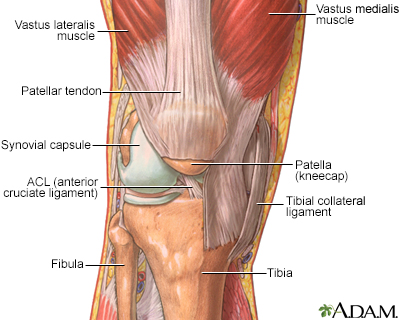Steroid injections - tendon, bursa, joint
A steroid injection is a shot of medicine used to relieve a swollen or inflamed area that is often painful. It can be injected into a joint, tendon, or bursa.
Description
Your health care provider inserts a small needle and injects medicine into the painful and inflamed area. Depending on the site, your provider may use an x-ray or ultrasound to see where to place the needle.
For this procedure:
- You will lie on a table or sit in a chair and the injection area will be cleaned.
- A numbing medicine may be applied to the injection site.
- Steroid injections can be given into a bursa, joint, or tendon.
BURSA
A bursa is a sac filled with fluid that acts as a cushion between tendons, bones, and joints. Swelling in the bursa is called bursitis. Using a small needle, your provider will inject a small amount of corticosteroid and a local anesthetic into the bursa.
JOINT
Any joint problem, such as arthritis, can cause inflammation and pain. Your provider will place a needle in your joint. Sometimes ultrasound or an x-ray machine may be used to see where exactly the needle is located. Your provider may then remove any excess fluid in the joint using a syringe attached to the needle. Your provider will then exchange the syringe and a small amount of corticosteroid and a local anesthetic will be injected into the joint.
TENDON
A tendon is a band of fibers that connects muscle to bone. Inflammation in the tendon can lead to tendonitis which can be painful. Your provider will put a needle directly adjacent to the tendon and inject a small amount of corticosteroid and a local anesthetic.
You will be given a local anesthetic along with the steroid injection to relieve your pain right away. The steroid can take up to 5 to 7 days or so to start working.
Why the Procedure Is Performed
This procedure aims to relieve pain and inflammation in a bursa, joint, or tendon.
Risks
Risks of steroid injection may include:
- Pain and bruising at the site of the injection
- Swelling
- Irritation and discoloration of the skin at the injection site
- Allergic reaction to the medicine
- Infection
- Bleeding in the bursa, joint, or tendon
- Damage to nerves near the joint or soft tissue
- An increase in your blood glucose level for several days after the injection if you have diabetes
Before the Procedure
Your provider will tell you about the advantages and possible risks of the injection.
Tell your provider about any:
- Health problems
- Medicines you take, including over-the-counter medicines, herbs, and supplements
- Allergies
- History of diabetes and how well your blood sugar level has been controlled
Ask your provider if you should have someone to drive you home.
After the Procedure
The procedure typically takes 15 to 30 minutes. You can go home the same day.
- You might have slight swelling and redness around the injection site.
- If you have swelling, apply ice over the site for 15 to 20 minutes, 2 to 3 times per day. Use an ice pack wrapped in a cloth. DO NOT apply ice directly to skin.
- Avoid a lot of activity the day you get the shot.
If you have diabetes, your provider will advise you to check your glucose level more often for 1 to 5 days. The steroid that was injected can raise your blood sugar level, most often only by a small amount.
Look for pain, redness, swelling, or fever. Contact your provider if these signs are becoming worse.
Outlook (Prognosis)
You may notice a decrease in your pain for the first few hours after the shot. This is due to the numbing medicine. However, this effect will wear off.
After the numbing medicine wears off, the same pain you were having before may return. This may last several days. The effect of the injection will start usually 5 to 7 days after the injection. This can decrease your symptoms.
At some point, most people feel less or no pain in the tendon, bursa, or joint after a steroid injection. Depending on the problem, your pain may or may not return.
Reviewed By
C. Benjamin Ma, MD, Professor, Chief, Sports Medicine and Shoulder Service, UCSF Department of Orthopaedic Surgery, San Francisco, CA. Also reviewed by David C. Dugdale, MD, Medical Director, Brenda Conaway, Editorial Director, and the A.D.A.M. Editorial team.
Adler RS. Musculoskeletal interventions. In: Rumack CM, Levine D, eds. Diagnostic Ultrasound. 6th ed. Philadelphia, PA: Elsevier; 2024:chap 23.
Gupta N. Treatment of bursitis, tendinitis, and trigger points. In: Roberts JR, Custalow CB, Thomsen TW, eds. Roberts and Hedges' Clinical Procedures in Emergency Medicine and Acute Care. 7th ed. Philadelphia, PA: Elsevier; 2019:chap 52.
Saunders S, Longworth S. Practical guidelines for injection therapy in musculoskeletal medicine. In: Saunders S, Longworth S, eds. Injection Techniques in Musculoskeletal Medicine. 5th ed. Philadelphia, PA: Elsevier; 2019:section 2.
Waldman SD. Deep infrapaterellar bursa injection. In: Waldman SD, ed. Atlas of Pain Management Injection Techniques. 5th ed. Philadelphia, PA: Elsevier; 2023:chap 160.



 All rights reserved.
All rights reserved.